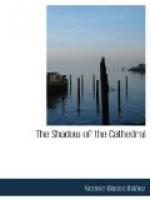[Footnote 1: Virile—small box with double glass in which the Host is exhibited.]
“The Church,” said Gabriel to himself, “ages everything she touches. The treasures lose their brilliancy in her hands, like jewels that fall into the power of usurers. The diamond becomes dulled in the bosom of the great miser, and the most beautiful picture becomes blackened on her altars.”
After the visit to the Treasury came the exhibition of the Ochavo, the octagonal chapel of dark marbles, that pantheon of relics where the most repulsive human remains—skulls with their ghastly grin, mummified arms and worn-eaten vertebras—were shown in gold or silver shrines. The gross and credulous piety of former days displayed itself in the full tide of unbelief, so that even Don Antolin, so uncompromising when he spoke of the glories of his Cathedral, lowered his voice and hurried over his explanations as he showed a piece of the mantle worn by Santa Leocadia when she “appeared” to the Archbishop of Toledo, quite understanding the difficulty of explaining how an apparition could wear garments of stuff.
Gabriel translated faithfully Don Antolin’s explanation, repeating it again and again with imperturbable gravity, while the canons who escorted the batch of strangers drew a few paces away with an absent look, to avoid questions.
One day a phlegmatic Englishman interrupted the interpreter.
“And have you not amongst all these things a feather from the wings of St. Michael?”
“No, senor, and it is a great pity,” said Luna, equally seriously, “but you will probably find it in some other Cathedral; we cannot have everything here.”
In the Chapter-house, a mixture of Arab and Gothic architecture, the foreigners were much interested by the double row of portraits of the Toledan archbishops hanging on the wall, with their mitres and golden croziers. Gabriel called their attention to the picture of Don Cerebruno, a mediaeval prelate, so called from his enormous head; but it was the wardrobe which more especially surprised the foreigners.
It was a room surrounded by large cupboards and shelves of old wood; above these the walls were covered with dusty and torn pictures, copies of Flemish paintings that the canons had relegated to this corner; round the room were placed in line the ancient armchairs of the church, some of Spanish workmanship, austere, with straight lines and ravelled coverings, others of Greek design with curved feet inlaid with ivory. The capes and chasubles were piled on the shelves, according to colours, with the collars outside the heap, so that people could examine the wonderful embroidery. A whole world of patterns appeared with every possible brilliancy of colour on a few inches of stuff. The astonishing art of the ancient embroiderers made the silk a series of vivid pictures; the collar and the narrow stripes on the front of a cape were large enough to reproduce all the scenes of the biblical




